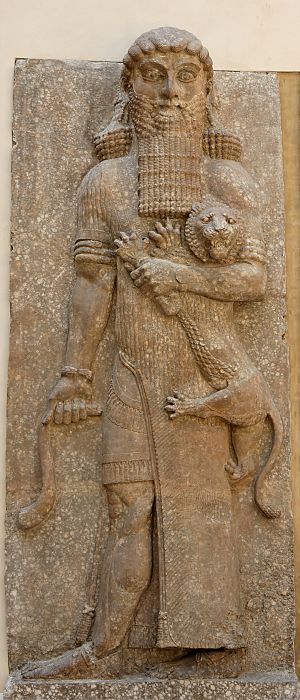Gilgamesh facts for kids
Quick facts for kids Gilgamesh𒀭𒄑𒂆𒈦 𒀭𒄑𒉋𒂵𒎌 |
|
|---|---|
| King of Uruk | |

Possible representation of Gilgamesh as Master of Animals, grasping a lion in his left arm and snake in his right hand, in an Assyrian palace relief (713–706 BC), from Dur-Sharrukin, now held in the Louvre
|
|
| Reign | c. 2900–2700 BC (EDI) |
| Predecessor | Dumuzid |
| Successor | Ur-Nungal |
| Issue | Ur-Nungal |
| Father | Lugalbanda (in Sumerian poetry) |
| Mother | Ninsun (in Sumerian poetry) |
Gilgamesh was a famous hero from ancient Mesopotamian stories. He is the main character of the Epic of Gilgamesh, a very old and long poem. This poem was written in the Akkadian language around 1000 BC.
Many people believe Gilgamesh was a real king of Uruk. Uruk was an important Sumerian city-state in ancient Mesopotamia. He might have ruled around 2900 to 2350 BC. After his death, people began to see him as a god. He became a very important figure in Sumerian legends during the Third Dynasty of Ur (around 2112–2004 BC).
Tales about Gilgamesh's amazing adventures are told in five old Sumerian poems. One of the earliest is "Gilgamesh, Enkidu, and the Netherworld". In this story, Gilgamesh helps the goddess Inanna. He chases away creatures from her special huluppu tree. She gives him two mysterious items, which he later loses. After his friend Enkidu dies, Enkidu's ghost tells Gilgamesh about the sad conditions in the Underworld.
Another poem, Gilgamesh and Aga, describes Gilgamesh fighting against his ruler, Aga of Kish. Other Sumerian poems tell how Gilgamesh defeated the giant Huwawa and the powerful Bull of Heaven. A fifth poem, which is not well-preserved, talks about his death and funeral.
Contents
The Epic of Gilgamesh: A Journey for Immortality
Later, during the Babylonian period, these separate stories were combined. They formed one long, connected story. The most famous version, the Akkadian Epic of Gilgamesh, was written by a scribe named Sîn-lēqi-unninni. This happened around 1600–1155 BC. He used much older stories to create this epic poem.
In the epic, Gilgamesh is a demigod. This means he is part human and part god, with amazing strength. He becomes best friends with a wild man named Enkidu. Together, they go on many dangerous journeys. Their most famous adventures include defeating the giant Humbaba and the Bull of Heaven. The goddess Ishtar sends the Bull of Heaven to attack them. She does this after Gilgamesh refuses her offer to become her husband.
After Enkidu dies from a disease sent by the gods, Gilgamesh becomes very scared of death. He decides to search for a way to live forever. He visits the wise man Utnapishtim, who survived a great flood. Gilgamesh hopes to learn the secret of immortality from him. However, Gilgamesh fails the challenges Utnapishtim gives him. He eventually returns home to Uruk, understanding that living forever is not possible for him.
Gilgamesh's Influence on Later Stories
Many experts believe the Epic of Gilgamesh greatly influenced two famous Greek poems. These are the Iliad and the Odyssey, written around the 8th century BC. The story of Gilgamesh's birth is also mentioned by a Greek writer named Aelian. He wrote about it in his book On the Nature of Animals in the 2nd century AD.
Aelian tells a story that Gilgamesh's grandfather kept his mother guarded. He did this to stop her from getting pregnant. An oracle had told him that his grandson would overthrow him. But she did become pregnant. The guards then threw the baby from a tall tower. Luckily, an eagle caught the child in mid-air. The eagle safely delivered him to an orchard, where a gardener raised him.
Rediscovery and Modern Importance
The Epic of Gilgamesh was found again in the Library of Ashurbanipal in 1849. This was a very old library in ancient Mesopotamia. When it was translated in the early 1870s, it caused a lot of discussion. This was because some parts of the epic were similar to stories in the Hebrew Bible.
For a long time, Gilgamesh was not very well known. But since the late 20th century, he has become much more famous. He is now a prominent figure in modern culture, appearing in books, movies, and games.
Was Gilgamesh a Real King?
Most historians agree that Gilgamesh was a real king. He ruled the Sumerian city-state of Uruk. His rule likely happened during the early Early Dynastic Period, between 2900 and 2350 BC. A scholar named Stephanie Dalley says that Gilgamesh probably lived between 2800 and 2500 BC.
An ancient writing found at Ur might belong to an official who lived at the same time as Gilgamesh. This writing says: "Gilgameš is the one whom Utu has selected." Also, the Tummal Inscription, a historical text from around 1953–1920 BC, mentions him. This inscription gives Gilgamesh credit for building the walls of Uruk.
Gilgamesh is also linked to King Enmebaragesi of Kish. Enmebaragesi was a known historical figure. He might have lived around the same time as Gilgamesh. The Sumerian King List also lists Gilgamesh as one of the kings of Uruk. Some ancient texts found in Mê-Turan say that Gilgamesh was buried under a river bed when he died. The workers of Uruk even changed the flow of the Euphrates river for a short time to bury him there.
See also
 In Spanish: Gilgamesh para niños
In Spanish: Gilgamesh para niños
- Atra-Hasis
- Ziusudra
- Enūma Eliš
- Gilgamesh: A New English Version
- Ancient literature

